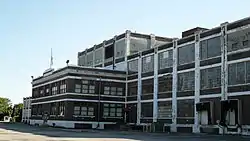Libby, McNeill and Libby Building
The Libby, McNeill and Libby Building is an industrial building on Western Avenue in Blue Island, Illinois. It was designed by Philip Larmon and built between 1917 and 1919. It originally served as Libby, McNeill and Libby's main Midwest processing plant.[2]
| Libby, McNeill and Libby Building | |
|---|---|
 | |
| General information | |
| Location | 13636 S. Western Avenue, Blue Island, Illinois |
| Coordinates | 41°38′42.11″N 87°40′51.24″W |
| Completed | 1917-1919 |
| Technical details | |
| Floor count | 4 |
| Floor area | 550,000 square feet (51,000 m2)[1] |
| Design and construction | |
| Architect(s) | Philip Larmon |
History

The plant was built between 1917 and 1919.[2] Situated on a 22-acre property at the Baltimore and Ohio Chicago terminal, it was designed by Philip Larmon and built by C. A. Moses Construction Company at a cost of approximately $500,000.[2][3][4] Libby, McNeill and Libby moved into the building in mid-June 1918.[3] The northernmost rear wing was completed in 1919, and served as the "Tomato Building", while the southernmost wing was the "Pickle Building".[2][3] A wide variety of foods were canned and bottled at this plant, including pickles, catsup, mustard, salad dressing, jellies, apple butter, baked beans, and olives.[5]
Libby's closed the plant in 1968.[2][6] In the 1980s, the building was redeveloped as the Blue Island Industrial Terminal and would go on to house a variety of small businesses, including a fiberglass boat manufacturer and an electrical conduit manufacturer.[1][7][8] In 2018, the building was donated to Affordable Recovery Housing, a nonprofit organization serving homeless people and recovering addicts.[8][9] Affordable Recovery Housing organized free COVID-19 testing on the property, during the COVID-19 pandemic.[10]
References
- Kerch, Steve. "It's finally time for the Industrial Renovation Series", Chicago Tribune. July 30, 1989. Retrieved July 17, 2021.
- "Request for Preliminary Determination of Eligibility: Libby, McNeill & Libby Canning Plant 13636 South Western Avenue, Blue Island, Illinois" (PDF). las.depaul.edu. DePaul University: College of Liberal Arts and Social Sciences. Retrieved July 17, 2021.
- "Building News", The Economist. July 20, 1918. p. 128. Retrieved July 17, 2021.
- National Real Estate Journal. Vol 16, No. 3. September 1917. p. 300. Retrieved July 17, 2021.
- "The Margin of Profit in Variety Canning", Canning Age. March 1922. p. 5. Retrieved July 17, 2021.
- "Blue Island Plant to Close in April", Chicago Tribune. December 31, 1967. Section 10, p. 3.
- "Dominick's Plans 'Superstore'", Chicago Tribune. February 1, 1987. Retrieved July 17, 2021.
- Slowik, Ted. "Blue Island warns addict recovery agency of code violation, exposing political feud in the process", Daily Southtown. September 15, 2018. Retrieved July 17, 2021.
- Slowik, Ted. "Former Blue Island boarding school now a live-in recovery center for addicts with clinic, library and classrooms", Daily Southtown. June 23, 2018. Retrieved July 17, 2021.
- Wright, Jesse. "Nonprofit organizes free COVID-19 test site for Blue Island community", Daily Southtown. September 23, 2020. Retrieved July 17, 2021.